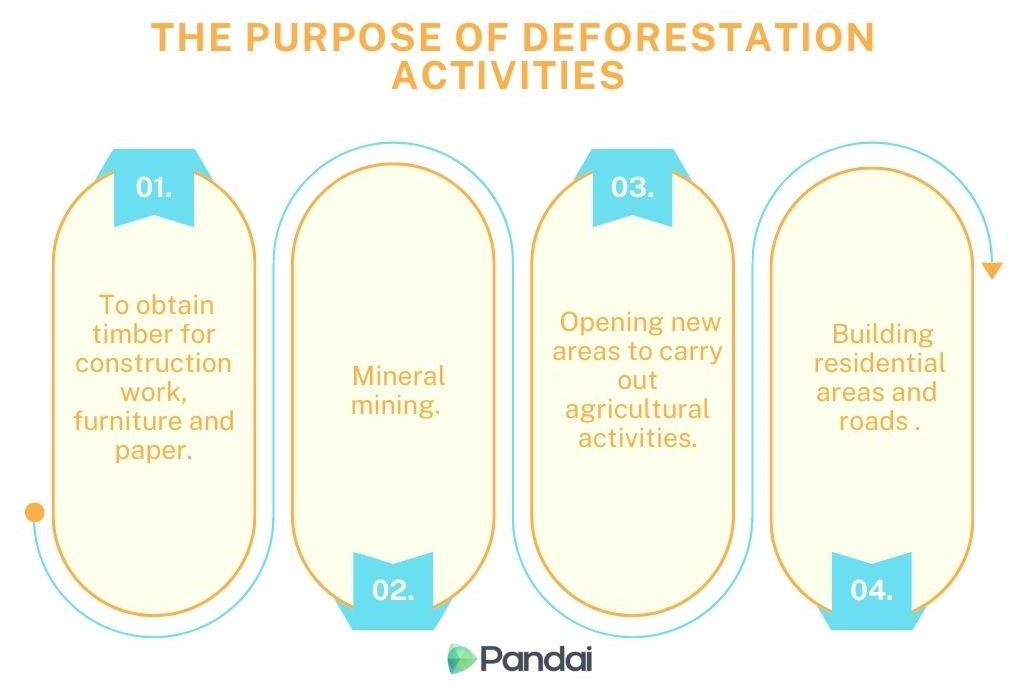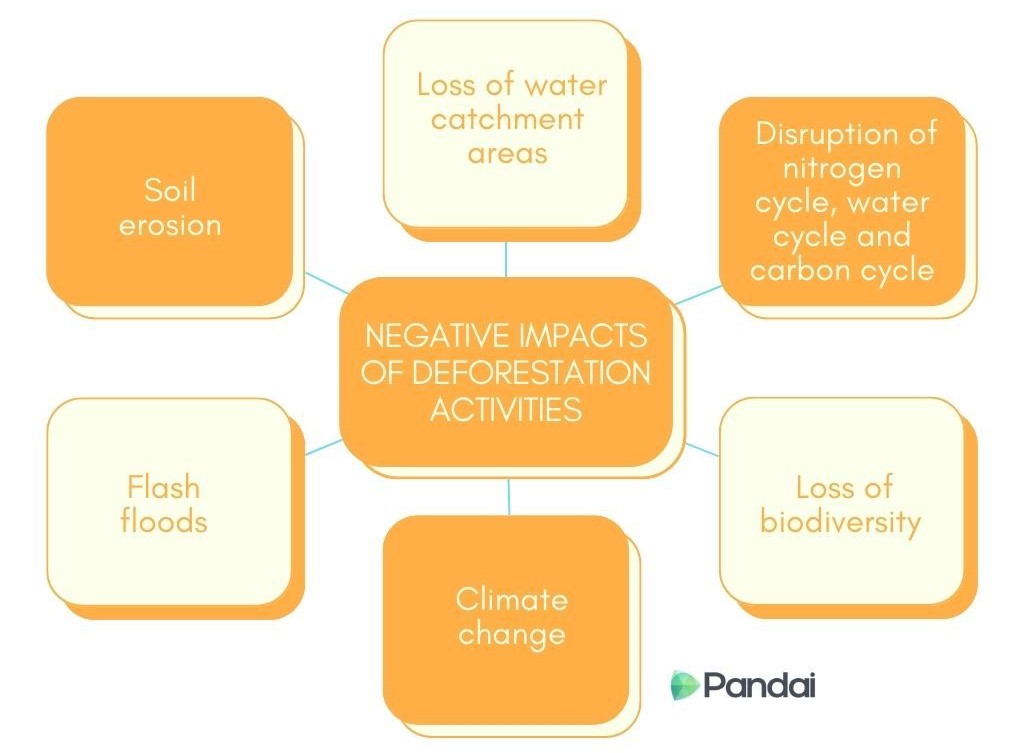| Examples of Environmental Threats |
| Climate Change and Global Warming |
- A climate change refers to drastic changes in the earth’s temperature, rainfall distribution and wind changes.
- This change can be seen from the phenomenon of the greenhouse effect.
- When sunlight enters the earth's atmosphere, part of that radiation is reflected back to the earth's atmosphere in the form of infrared rays.
- During the release of thermal energy, most of it will be absorbed by greenhouse gases such as carbon dioxide gas, methane gas, nitrogen oxide gas and chlorofluorocarbon (CFC) gas found in the earth’s atmosphere and prevent it from being reflected back into space.
- This unreflected heat energy ensures that the earth’s temperature is not too cold for the survival of the organism.
- Most gases such as carbon dioxide gas are formed naturally.
- However, human activity has caused the concentration of these gases to increase and more thermal energy to be trapped, further increasing the earth’s temperature.
- This condition is known as the greenhouse effect.
- The table below shows the factors causing greenhouse effect and greenhouse gases involved.
| Factors Causing Greenhouse Effect |
Greenhouse Gases Involved |
| Burning of fossil fuels. |
Carbon dioxide and nitrogen dioxide. |
| Deforestation. |
Carbon dioxide. |
| Animal farming. |
Methane. |
| Agriculture activities (nitrogen fertiliser). |
Nitrogen dioxide. |
| Usage of cooling substances. |
Chlorofluorocarbon (CFC). |
- El Nino phenomenon causes extreme hot and dry weather which results in draught.
- La Nina phenomenon causes unusual heavy rain which results in a serious flood.
|
| Deforestation and Loss of Biodiversity |
- Deforestation is the massive felling of trees. Deforestation is a major cause of biodiversity loss.
- Habitat loss due to deforestation for development and agricultural activities has led to the extinction of many species of flora and fauna.
- The The purpose of deforestation activities and the negative impacts of deforestation activitie is as shown below:


- Global changes caused by pollution are contributing to the loss of biodiversity.
- Illegal hunting of wildlife for the purposes of the food, medical and handicraft industries has resulted in a reduction in the population of animal species leading to the extinction of the species.
- In addition, acid rain caused the pH of the water to below, most fish eggs could not hatch and some adult fish died.
|
- Increased alga growth, mortality of aquatic life and deterioration of water quality are the effects of the eutrophication process.
- Eutrophication is the process of a water ecosystem becoming rich in nutrients that cause changes in the structure of the ecosystem.
- Excessive use of nitrate and phosphate fertilizers in agricultural activities and other factors also cause eutrophication.
- Excess nitrate and phosphate residues are discharged by rainwater into lakes and rivers. The increase in nitrate and phosphate stimulates the growth of algae so rapidly that it covers the surface of the water.
- This condition is called eutrophication. This condition reduces the penetration of sunlight into the water.
- The rate of photosynthesis by aquatic plants becomes low and the dissolved oxygen content in water becomes low. This causes aquatic plants and animals to die. The more algae and aquatic organisms die, the higher the population of decomposing bacteria.
- Decomposing bacteria will decompose dead aquatic plants and animals in the presence of oxygen, causing extreme oxygen depletion in the water. This increases the level of biochemical oxygen demand or biochemical oxygen demand (BOD).
- Biochemical oxygen demand (BOD) is the amount of oxygen required by microorganisms such as bacteria and fungi to break down organic matter in water.
- High BOD levels indicate that the quality of the water source is low and indicates that there are many organic matters as well as decomposing microorganisms in the water.
- Low BOD levels indicate good water quality. This is because the dissolved oxygen content is high and the water is not polluted.
|
- There are three types of air pollution:
- Air pollution.
- Thermal pollution.
- Noise pollution.
- Air pollution:
- Air pollution happens when there is an increase in the pollutant substances such as gases, smoke, dust and particles in the atmosphere which affect health and lives of human beings, animals and plants.
- These pollutants increase when there is a rise of smog and gases released by vehicles as well as industrial factories and also from open burning.
- The burning of fossil fuels by charcoal burning plants, industrial factories and vehicles releases carbon monoxide, nitrogen oxide and sulphur dioxide into the atmosphere.
- These gases combine with water vapour in the atmosphere to form nitric acid and sulphuric acid, and later come down as acid rain.
- Acid rain causes the soil to become infertile due to the pH value of less than 5.
- Acid rain also destroys leaf tissues and damages the roots of plants. In addition, an increase in water acidity reduces plankton population which is the food source for fish.
- This affects the food chain and can cause the death of various organisms.
- Acid rain also causes skin diseases and tissue damage in humans.
- The table below shows the source of air pollutions and the pollutants.
| Source of Air Pollution |
Pollutants |
| Exhaust fumes from vehicles |
- Nitrogen oxide.
- Carbon monoxide.
- Lead.
- Smoke and soot (small particles of carbon).
- Hydrocarbon gases (example: benzene).
|
| Smoke from industrial factories |
- Sulphur dioxide.
- Nitrogen oxide.
- Dust.
- Carbon monoxide.
- Carbon dioxide.
|
| Open burning |
- Carbon dioxide.
- Smoke and soot.
|
- Thermal pollution:
- Thermal pollution refers to the deterioration of water quality due to the removal of excess heat into the water due to processes that change the temperature of the water.
- Water is used as a cooling agent to cool generators in industrial plants and electric power stations.
- The resulting hot water is then channelled back into the river or into the lake and this causes thermal pollution.
- The increase in river water temperature is not suitable for aquatic habitats.
- As the water temperature rises, the dissolved oxygen content in the water decreases and complicates the survival of aquatic life.
- Thermal pollution will disrupt and endanger the life of organisms and the environment.
- An increase in water temperature disrupts biochemical processes in aquatic organisms because usually fish and other aquatic animals can only survive in a certain temperature range.
- For example, an increase in water temperature can cause fish eggs to hatch earlier or fail to hatch.
- For some species, a sudden increase in water temperature can cause immediate death.
- For organisms such as algae, higher temperatures will encourage their growth.
- Alga growth in turn increases the BOD level of the water.
- Noise pollution:
- Noise pollution is the noise that disturbs and harms human and animal health.
- Vehicle noise, construction activities, agricultural and industrial machinery as well as loud music from celebrations are a form of noise pollution.
- Continuous exposure to noise can cause stress-related health problems such as high blood pressure, cardiovascular disease, depression and headaches.
|
| Human Population Growth Explosion |
- Population growth explosion is an increase in the number of people living in a particular area
- As population growth increases rapidly, the depletion of environmental resources also occurs rapidly, leading to deforestation, loss of biodiversity and global warming.
- Forest areas are being cut down to provide settlement, development, agriculture and facilities to the growing population.
- As a result of these activities, organisms are exposed to various threats such as problems with raw water resources and clean water supply, increased pollution and disease, and subsequent extinction of biodiversity.
- Demand for water and resources from the locals cannot be fully managed with the available environmental resources in the area.
- This causes the relocation of resources from remote locations to areas of demand.
- In addition, sewage waste will also pose a threat of pollution to the environment.
- To overcome this problem, water treatment technology is used but will result in an increase in the cost of water resources including treated water.
|
|